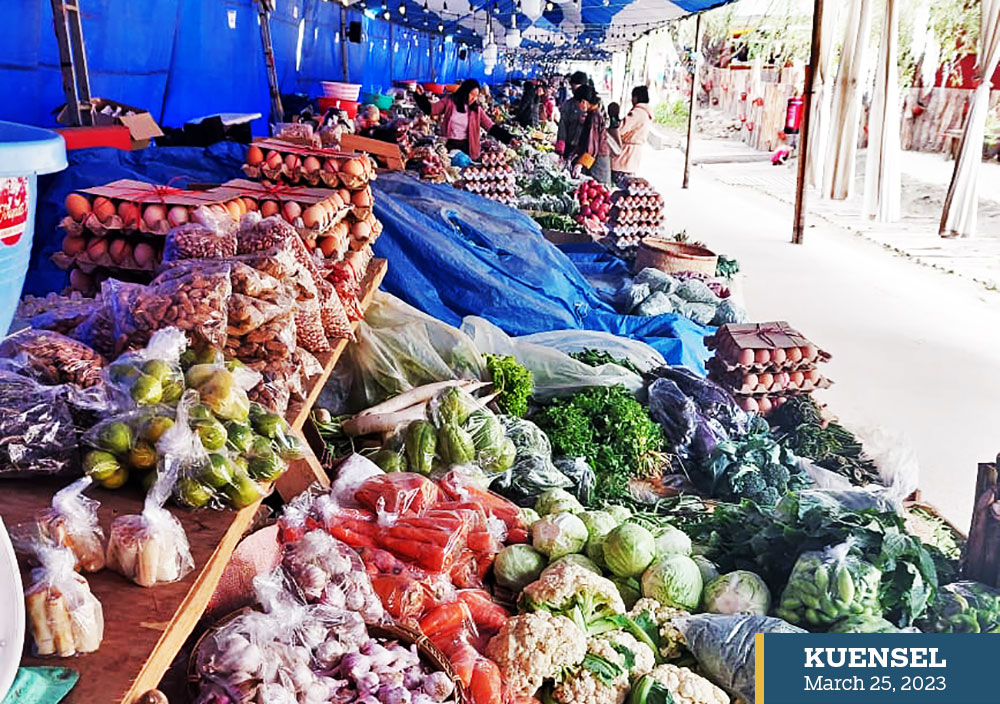Choki Wangmo
Consecutive national reports in recent years pointed out that the Bhutanese people need to eat more fruits and vegetables as part of a balanced diet. Consumers in urban areas say that their monthly income cannot afford a healthy eating habit.
A young civil servant whose monthly salary is Nu 23,000 said that although she wants to change her dietary patterns by adding more fruits and vegetables, it is beyond her means. For the lone bread earner in the family, it is not about the availability of fruits and vegetables but her ability to buy.
Her monthly income gets divided into house rent, utility bills, and loan repayment. “Fruits are not even on the priority list.” “I can hardly afford to buy fruits twice in a month which is why I am left with no choice but to eat the rice which is quite affordable and lasts longer,” she said.
Fill the Nutrient Gap analysis reported that the cost of a nutritious diet in Bhutan is four times more than the cost of meeting only energy needs.
A corporate employee says that fruits and vegetables are readily available in the market but the price is high.
Her mother buys fruits and vegetables once a week worth Nu 2,000. The family’s monthly expenditure on fruits and vegetables is Nu 8,000. “Apples cost from Nu 250 to Nu 300 for a kg. It is expensive for someone earning about Nu 15,000 in a month.”
The family goes to buy what is affordable such as bananas, watermelon, and cucumber. “Nuts such as almond and cashew are out of the question,” she added.
In vegetable markets across Thimphu, a kg each of imported pear, apple, mango, oranges, banana, and grapes costs about Nu 2,000. The only local fruits available during winter in the city are oranges and bananas which are equally expensive.
“I cannot take the recommended levels of fruits and vegetables because of the cost of locally-grown fruits. Lower and middle-income earners like me cannot afford fruits and vegetables,” another corporate employee said.
Many consumers, if they had choices, said would opt to eat a balanced diet rich in fruits and vegetables. “The price of vegetables keeps on increasing, so do the fruits. And fruits are more expensive than vegetables,” a consumer said.
A chief-level public servant spends 35 percent of his monthly salary on house rent, 20 percent on groceries, and the remaining amount on utility, social obligations, and personal expenses. Every month, for his five family members, he spends Nu 4,500 for fruits and vegetables. He buys vegetables every week and fruits fortnightly. He says that the cost is reasonable although the cost of some imported fruits and a few local vegetables is high.
Bhutan faces the triple burden of malnutrition – undernutrition, overnutrition, and micronutrient deficiencies. One in five children is stunted, one in three adolescent girls suffers from iron deficiency anaemia and an increasing number of children are becoming overweight. The latter has increased from 11 percent in 2019 to 14 percent in 2022.
According to findings of the Fill the Nutrient Gap analysis, 27 percent of households in the country cannot afford to meet their nutrient requirements.
A 2019 study by the health ministry found that Bhutanese need to eat more fruits and vegetables. The ministry says for someone to live a healthy life one needs to eat at least five servings of fruits and vegetables a day. The average Bhutanese eats only three servings of fruit and vegetables a day.
It was found that people with insufficient intake of fruits and vegetables accounted for 86 percent of non-communicable diseases (NCDs). The Annual Health Bulletin 2020 reported that NCDs accounted for more than 70 percent of the reported deaths in the country in 2019.
What could be done?
The Fill the Nutrient Gap analysis recommends the food system to promote market-led production of nutritious crops and livestock to improve dietary diversity and strengthen the agriculture information management system to monitor the price and availability of nutritious foods weekly, including in rural and urban markets.
Consumers say that fruits and vegetables in Bhutan are seasonal and there are not many choices for them.
A consumer said that the agencies cannot instruct what to eat and what not to eat without first evaluating the market through research and development. “The cost is directly associated with the cost of production and the supply chain.”
For instance, a woman working in the town area said that her mother in Trashiyangtse harvested two bolero pick-up of truckscucumbers and other fruits from her land. But, without market access, most of her produce was wasted.
“If she decides to bring it to an urban area, the expenses would increase, thus, the cost of produce,” she said.
Some said that the government can do so much by removing the middlemen which would help in bringing the benefits directly to the farmer who produces the goods and the end consumers.
One consumer said that the government should spearhead large-scale production and establish post-harvest storage facilities to ensure an uninterrupted supply of fruits and vegetables throughout the year. It includes high yield, climate and pest resilience, and superior quality seeds and saplings.
“There should be government interventions in issues such as human-wildlife conflict so that farmers are encouraged to take up commercial farming,” he added.


